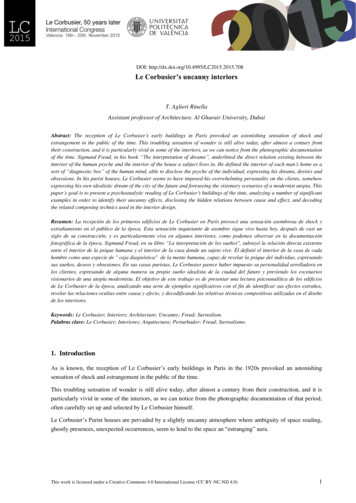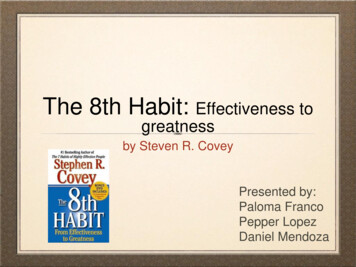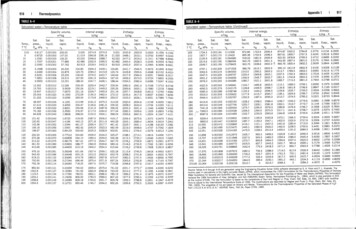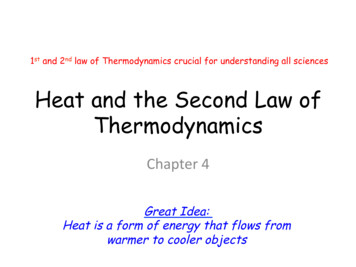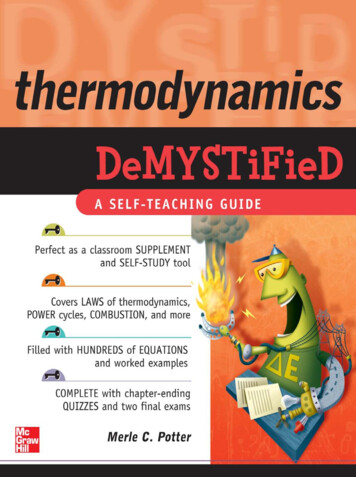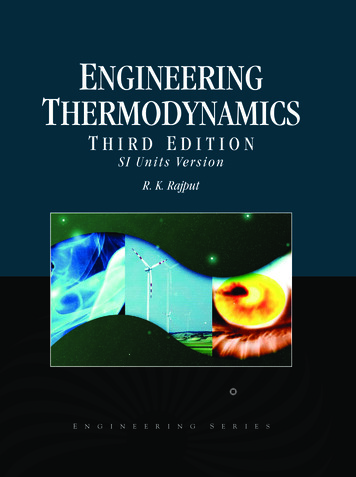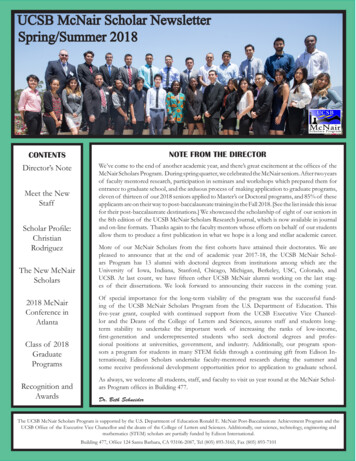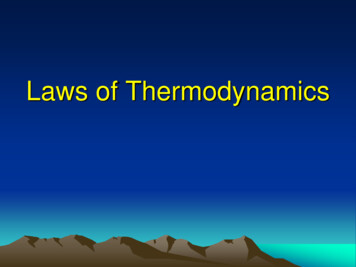
Transcription
Laws of Thermodynamics
Thermodynamics Thermodynamics is the study of theeffects of work, heat, and energy on asystem Thermodynamics is only concerned withmacroscopic (large-scale) changes andobservations
Getting Started All of thermodynamics can be expressedin terms of four quantities– Temperature (T)– Internal Energy (U)– Entropy (S)– Heat (Q) These quantities will be defined as weprogress through the lesson
Classical vs Statistical Classical thermodynamics concerns therelationships between bulk properties ofmatter. Nothing is examined at the atomicor molecular level. Statistical thermodynamics seeks toexplain those bulk properties in terms ofconstituent atoms. The statistical parttreats the aggregation of atoms, not thebehavior of any individual atom
IntroductionAccording to British scientist C. P. Snow,the three laws of thermodynamics can be(humorously) summarized as1. You can’t win2. You can’t even break even3. You can’t get out of the game
1.0 You can’t win (1st law) The first law of thermodynamics is anextension of the law of conservation ofenergy The change in internal energy of a systemis equal to the heat added to the systemminus the work done by the systemΔU Q - W
Slide courtesy of NASA
1.1 Process Terminology Adiabatic – no heat transferredIsothermal – constant temperatureIsobaric – constant pressureIsochoric – constant volume
1.1.1 Adiabatic Process An adiabatic process transfers no heat– therefore Q 0 ΔU Q – W When a system expands adiabatically, Wis positive (the system does work) so ΔUis negative. When a system compresses adiabatically,W is negative (work is done on thesystem) so ΔU is positive.
1.1.2 Isothermal Process An isothermal process is a constanttemperature process. Any heat flow into orout of the system must be slow enough tomaintain thermal equilibrium For ideal gases, if ΔT is zero, ΔU 0 Therefore, Q W– Any energy entering the system (Q) mustleave as work (W)
1.1.3 Isobaric Process An isobaric process is a constant pressureprocess. ΔU, W, and Q are generally nonzero, but calculating the work done by anideal gas is straightforwardW P·ΔV Water boiling in a saucepan is an exampleof an isobar process
1.1.4 Isochoric Process An isochoric process is a constant volumeprocess. When the volume of a systemdoesn’t change, it will do no work on itssurroundings. W 0ΔU Q Heating gas in a closed container is anisochoric process
1.2 Heat Capacity The amount of heat required to raise acertain mass of a material by a certaintemperature is called heat capacityQ mcxΔT The constant cx is called the specific heatof substance x, (SI units of J/kg·K)
1.2.1 Heat Capacity of Ideal Gas CV heat capacity at constant volumeCV 3/2 R CP heat capacity at constant pressureCP 5/2 R For constant volumeQ nCVΔT ΔU The universal gas constant R 8.314 J/mol·K
2.0 You can’t break even (2nd Law) Think about what it means to not “breakeven”. Every effort you put forth, no matterhow efficient you are, will have a tiny bit ofwaste. The 2nd Law can also be stated that heatflows spontaneously from a hot object to acold object (spontaneously means without the assistance ofexternal work)
Slide courtesy of NASA
2.1 Concerning the 2nd Law The second law of thermodynamicsintroduces the notion of entropy (S), ameasure of system disorder (messiness) U is the quantity of a system’s energy, S isthe quality of a system’s energy. Another C.P. Snow expression:– not knowing the 2nd law of thermodynamics is the culturalequivalent to never having read Shakespeare
2.2 Implications of the 2nd Law Time marches on– If you watch a movie, how do you know thatyou are seeing events in the order theyoccurred?– If I drop a raw egg on the floor, it becomesextremely “disordered” (greater Entropy) –playing the movie in reverse would showpieces coming together to form a whole egg(decreasing Entropy) – highly unlikely!
2.3 Direction of a Process The 2nd Law helps determine the preferreddirection of a process A reversible process is one which canchange state and then return to theoriginal state This is an idealized condition – all realprocesses are irreversible
2.4 Heat Engine A device which transforms heat into workis called a heat engine This happens in a cyclic process Heat engines require a hot reservoir tosupply energy (QH) and a cold reservoir totake in the excess energy (QC)– QH is defined as positive, QC is negative
2.4.1 Cycles It is beyond the scope of this presentation,but here would be a good place toelaborate on:– Otto Cycle– Diesel Cycle– Carnot Cycle Avoid all irreversible processes while adhering tothe 2nd Law (isothermal and adiabatic only)
2.4.2 The Carnot CycleImage from Keta - Wikipedia
2.4.2.1 Carnot explained Curve A (1 2): Isothermal expansion at TH– Work done by the gas Curve B (2 3): Adiabatic expansion– Work done by the gas Curve C (3 4): Isothermal compression at TC– Work done on the gas Curve D (4 1): Adiabatic compression– Work done on the gas
2.4.2.2 Area under PV curve The area under the PV curve representsthe quantity of work done in a cycle When the curve goes right to left, the workis negative The area enclosed by the four curvesrepresents the net work done by theengine in one cycle
2.5 Engine Efficiency The thermal efficiency of a heat engine ise 1 QC/QH The “engine” statement of the 2nd Law:– it is impossible for any system to have anefficiency of 100% (e 1) [Kelvin’s statement] Another statement of the 2nd Law:– It is impossible for any process to have as itssole result the transfer of heat from a coolerobject to a warmer object [Clausius’s statement]
2.6 Practical Uses Automobile engines, refrigerators, and airconditioners all work on the principles laidout by the 2nd Law of Thermodynamics Ever wonder why you can’t cool yourkitchen in the hot summer by leaving therefrigerator door open?– Feel the air coming off the back - you heat theair outside to cool the air inside– See, you can’t break even!
3.0 You can’t get out (3rd Law) No system can reach absolute zero This is one reason we use the Kelvintemperature scale. Not only is the internalenergy proportional to temperature, butyou never have to worry about dividing byzero in an equation! There is no formula associated withthe 3rd Law of Thermodynamics
3.1 Implications of 3rd Law MIT researchers achieved 450 picokelvinin 2003 (less than ½ of one billionth!) Molecules near these temperatures havebeen called the fifth state of matter:Bose-Einstein Condensates– Awesome things like super-fluidity and superconductivity happen at these temperatures– Exciting frontier of research
4.0 The Zeroth Law The First and Second Laws were wellentrenched when an additional Law wasrecognized (couldn’t renumber the 1st and 2nd Laws) If objects A and B are each in thermalequilibrium with object C, then A and B arein thermal equilibrium with each other Allows us to define temperature relative toan established standard
Slide courtesy of NASA
4.1 Temperature Standards See Heat versus Temperature slides for adiscussion of these two concepts, and themisconceptions surrounding them– Heat is energy transfer– Temperature is proportional to internal energy– Fahrenheit, Celsius, and Kelvin temp scales
According to British scientist C. P. Snow, the three laws of thermodynamics can be (humorously) summarized as 1. You can’t win. 2. You can’t even break even. 3. You can’t get out of the game . 1.0 You can’t win (1st law) The first law of thermodynamics is an extension of the law of conservation of energy The change in internal energy of a system is equal to the heat added to .


